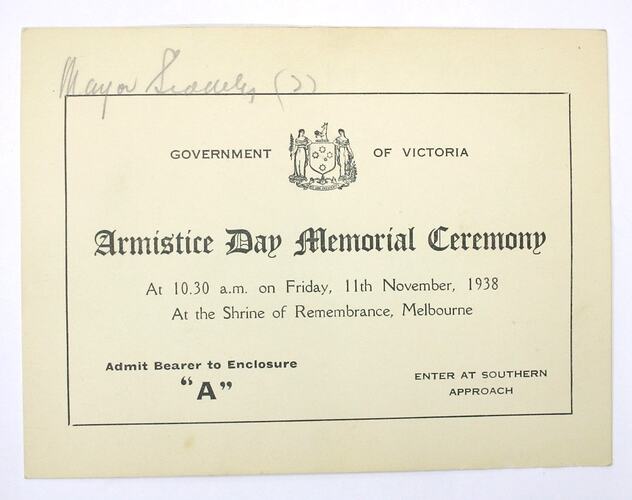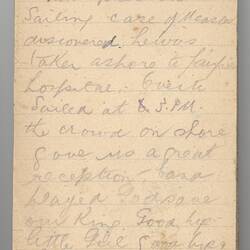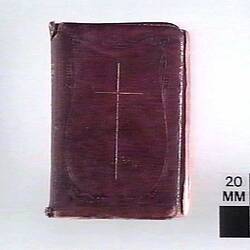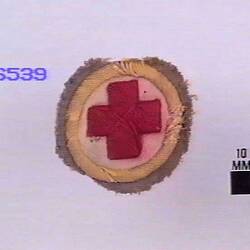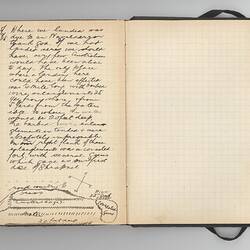Summary
Ticket for the Government of Victoria Armistice Day Memorial Ceremony, 10.30am Friday 11th November 1938, at the Shrine of Remembrance, Melbourne. Issued to Major Siddeley.
William McQueen Saxon ('S.W') Siddeley was a 19-year-old private secretary when he enlisted at Broadmeadows on 18 August 1914. Siddeley became a member of the Australian Army Medical Corps, First AIF, attached to the 5th Battalion, regimental number 1053. He embarked for service abroad on 21 October 1914, and took part in the first landing at Gallipoli on 24 April 1915. His character and conduct while serving in the AIF was described as 'good'.
In May 1915, while still in Gallipoli, Siddeley reported to have 'defective eyesight', and his Casualty Form indicates that he left for Australia on the 'Euripides' on 29 August 1915, arriving 1 October. After time in hospital in Australia, and extended furlough, he was discharged from the AIF on 15 May 1916, being 'medically unfit' 'not due to misconduct'. On 1 November 1916, he was sufficiently recovered to begin duties as a Canteen Sargent on the troopship HMT 'Afric'. He went overseas again, but only briefly: on 12 February 1917 the 'Afric' was torpedoed and sunk in the English Channel. Five died in the explosion and 17 drowned; 145 survived. This tragedy marked the end of Siddeley's war-time service: he left Plymoth for Australia on the 'Beltana' ('Services no longer required') on 17 March 1917, arriving in Australia in mid-May. After the War, Siddeley (ironically) became an eyesight specialist, working from the Finks Buildings, 6A Elizabeth Street, Melbourne. The effects of the war continued; the family reported that he had one short episode when he was admitted to the 'neurotic ward' at the Heidlelberg Repatriation Hospital. He died on 24 April 1971.
Physical Description
Ticket of pale yellow card, the details of the events printed in black ink on one side. The name of the invitee is handwritten in pencil in the upper left corner.
More Information
-
Collection Names
-
Collecting Areas
-
Acquisition Information
Donation & Subsequent Transfer from Victorian Branch, Returned & Services League of Australia Limited (RSL), Mrs Ethel C. Siddeley, Oct 1984
-
User
Corporal S. W. Siddeley - Australian Imperial Force (AIF), Melbourne, Victoria, Australia, 11 Nov 1938
-
Place & Date of Event
Shrine of Remembrance, Melbourne, Victoria, Australia, 11 Nov 1938
-
Inscriptions
Printed on Ticket: 'Major Siddley / GOVERNMENT OF VICTORIA / Armistice Day Memorial Ceremony / At 10.30 a.m. on Friday, 11th November, 1938 / At the Shrine of Remebrance, Melbourne / Admit Bearer to Enclosure "A" / ENTER AT SOUTHERN / APPROACH'
-
Classification
Military history, Commemorations, Armistice & remembrance day
-
Category
-
Discipline
-
Type of item
-
Overall Dimensions
11.4 cm (Length), 15.2 cm (Width)
-
Keywords
Armistice Day, Australian Army, Wars & Conflicts, World War I Armistice, 1918, World War I, 1914-1918
